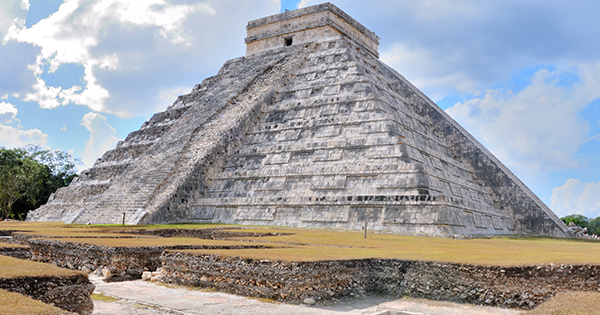
Eric H. Cline is a professor of classics and anthropology and the director of the Capital Archaeological Institute at George Washington University. He is the author of numerous books, most recently Three Stones Make a Wall: The Story of Archaeology, and has excavated in Europe, the Middle East, and North America. We asked him to pose three questions on the future of archaeology.
1. In 2009, a team of archaeologists mapped the sprawling, ancient Maya city of Caracol, a site in Belize that had been long obscured by dense jungle. The archaeologists had mounted a device called LiDAR—light detection and ranging—onto a twin-engine airplane. LiDAR is a type of remote sensing technology: laser beams are used to penetrate jungle or rainforests, bouncing off the ground to create complex three-dimensional images.
Last June, Australian archaeologist Damian Evans, using LiDAR in Cambodia, announced the discovery of medieval cities near Angkor Wat—possibly the most significant Southeast Asian archaeological find in the past century. Fluxgate gradiometers and cesium magnetometers can also help archaeologists do considerable work before ever picking up a shovel or a pick—meaning less damage to a site and its artifacts. So what technological advances can we expect in the future? Biology and chemistry, particularly DNA studies, should provide us with new analytical techniques. But could some of the techniques employed by Transportation Security Administration officers in airports help search for certain chemical compounds beneath the surface of the earth? Would partnerships with oil and gas exploration companies allow us to peer beneath a mound, to look at strata at specific depths?
2. In 1979, the British-American writer and illustrator David Macaulay published a satirical book called Motel of the Mysteries that imagined that life in North America had ceased to exist one day in 1985. Enter an amateur archaeologist named Howard Carson in the year 4022, who happens upon a site that he believes to be a tomb. What Carson (an obvious nod to Howard Carter, the excavator of King Tutankhamun’s tomb) has stumbled upon, however, is a motel room. It’s a wonderful sendup full of jokes sure to make an archaeologist laugh. Yet Macaulay is addressing a very real problem: the potential for misinterpretation.
When future archaeologists excavate the same structure on so many city street corners and find the same iconography associated with them—a crowned goddess with flowing locks—will they conclude that this mysterious Starbucks was an ancient religion? Will they come to the same conclusion about McDonald’s? Or will they, in the event that written records have not survived, interpret Ronald McDonald and the Starbucks goddess as the Zeus and Hera of our own age—that is, deities at the forefront of a grand pantheon? Yes, I’m joking, but archaeologists often assume that an unidentifiable object is associated with a religion or a cult.
With so much of our communication taking place online—a record that will either disappear or be impossible to read—will archaeologists conclude that ours was a largely illiterate society? If everything comes to a sudden, catastrophic end, à la Pompeii, what will excavators make of the strange devices made of plastic, metal, glass, and electronic circuitry gripped by every skeleton they find?
3. Driven almost certainly by the demand created by private collectors, the assault on the world’s archaeological sites and museums is proceeding at a level and pace previously unseen. Throughout the Middle East and North Africa, recent wars and uprisings have resulted in the destruction of artifacts and “looting on an industrial scale,” as the head of UNESCO, Irina Bokova, described the situation in Syria in 2015.
Looting dates back at least to the age of the Egyptian phar-aohs. The problem today isn’t restricted to war-torn regions: Greece and Peru have witnessed instances of looting, as has the United States. What’s at stake isn’t just the history and archaeological record of a particular site or region, but the remnants of our common human heritage.
The problem is that illegal digging for antiquities has been, in some parts of the world, a perfectly acceptable way to make a living. How can we fault an impoverished Syrian villager who sells a tablet or cylinder seal or figurine of a deity to some middleman so that his family can eat? This small-scale problem, however, has now gone wholesale. In Syria, ISIS has become an active player in the antiquities business, committing widespread acts of looting and destruction, for example, at Nimrud and the Mosul Museum [see our story on page 99]. The damage in Iraq is no less widespread, with hundreds of men carrying machine guns as well as shovels digging up sites all over the country. Recent photographs of the ancient city of Umma show no buildings, only the pits left by looters.
In 2015, President Obama signed the Protect and Preserve International Cultural Property Act, making it illegal in this country to sell looted Syrian artifacts. A memorandum of understanding between the United States and Egypt was signed late last year, restricting antiquities imported from Egypt. But what else can be done to protect our common cultural heritage and support careful, methodical archaeology? Legislation to guard excavated sites and protect known but unexcavated remains must also be passed. As individuals, we must resist the urge to buy an ancient artifact we find in some Middle Eastern market or on eBay. A lack of demand is the sure way to reduce supply. The one question that must concern us all is this: How can we stop the loss of knowledge of our collective human past before it’s too late?

